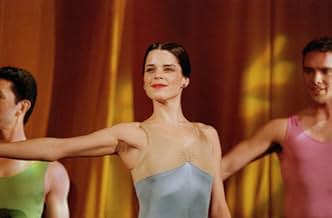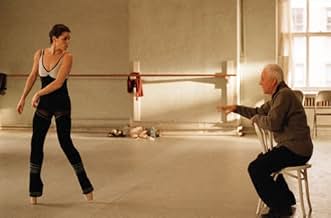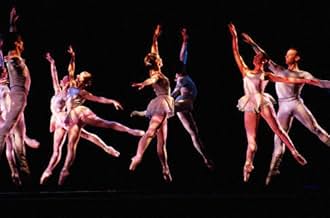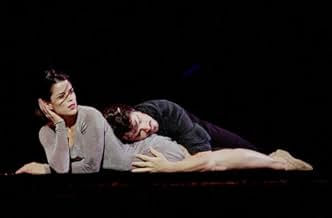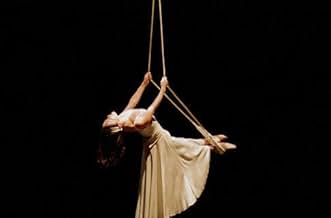IMDb रेटिंग
6.2/10
7 हज़ार
आपकी रेटिंग
अपनी भाषा में प्लॉट जोड़ेंA young ballet dancer is poised to become the principal performer in a group of ballet dancers.A young ballet dancer is poised to become the principal performer in a group of ballet dancers.A young ballet dancer is poised to become the principal performer in a group of ballet dancers.
- पुरस्कार
- 2 कुल नामांकन
Barbara E. Robertson
- Harriet
- (as Barbara Robertson)
Davis C. Robertson
- Alec - Joffrey Dancer
- (as Davis Robertson)
फ़ीचर्ड समीक्षाएं
George, what I think you meant to say was that you are actually a thick-headed mocho-man who has NO appreciation for the arts whatsoever. If you did, you'd understand that the ballet dancing in this movie was beautiful, and entitled a lot of hard work on the dancers' part. I've danced since I was three, and have met many male dancers along the way, and, to inform you, NOT ONE OF THEM WAS GAY! I'm a STRAIGHT female who has dated a male dancer before. Assumptions like that are completely childish. THe acting, dancing, setting, and costumes in this movie were wonderful. If you can't even appreciate fine movie-making, then you are surely at a loss. Even if you would rather be watching sports, which I completely understand, most men would, that's fine: however, it doesn't give you the right to judge an a form of art that you abviously don't understand.
Some of the dances are tiny religious experiences. The film doesn't look nearly as good as some of Altman's others, but there are flashes of awesome beauty: a topless male dancer alone in a room with golden beams of light, and Neve Campbell in her bath. The movie looks at the queeny pretensions of the boys (and their fathers), the dancers' sex lives (who are more '60s than their instructor knows), and the company leader, played by Malcolm McDowell, whose occasional flakiness is caught by one black dancer. I couldn't help but think of McDowell as an Altman self-criticism: an elderly director working with small budgets, prone to artiness, who champions art as being organic, who rounds up a large crew of performers and calls them "babies." The day-in-the-life shapelessness of the movie didn't at all bother me, though one character, who asks to stay in a dancer's apartment, is dropped pretty quickly. And James Franco is in it. 9/10
"The Company" is a lovely commercial for the Joffrey Ballet of Chicago (for New Yorkers this is in fact the same modern ballet company that used to be based at City Center but left the competitive dance fund raising environment here to have the stage to itself in Chicago).
A labor of love for producer/story writer/star/former dancer Neve Campbell, she was determined to make the first film about a whole company, not just using the dance world for a backdrop of individual melodrama, and with long passages of actual performances. So she brought in the primo director of ensembles, Robert Altman. But clearly she made compromises to get the film made that put his creativity as a director in a straight jacket and only lets his trademark talents fleetingly shine through.
The key was getting the Joffrey's cooperation and I can only imagine the tough negotiations that resulted in this pretty much being a whitewash of the ballet world, or of any creative endeavor, in sharp contrast to the behind-the-scenes reality shows "Project Greenlight" on HBO or "The Fire Within" about Cirque du Soleil's "Varekai" that was on Bravo. I surmise a long list of thou shalt not's that appear to include items such as:
-- no views of the non-artistic administrators, board, or fund raisers (there's a passing exhortation to a flashy choreographer Robet Desrosiers to stay within the budget, but he gets the complicated costumes and sets he wants anyway);
-- no homosexual relationships (there's a passing reference to the dancers AIDS has taken including "Bob", which cognoscenti have to know refers to the company's founder Robert Jeffrey, and Malcolm McDowall as the egotistical artistic director "Alberto Antonelli," a stand-in presumably for current company director Gerald Arpino, urges fellow Italian-American men not to make their boys, like he had to, "hide their ballet shoes");
-- no eating disorders (we do twice hear "Mr. A," half-jokingly, urge the company to eat salads and vegetables and there's one fast, quiet exchange in passing that I think was about diet pills);
-- blame dancers' problems on dysfunctional parents and mentors, recalling that vivid song from "A Chorus Line" - "Everything was beautiful at the ballet" as dancers seek to escape messy situations through temporary perfect beauty.
Altman does get to assert his artistic priorities in a few ways. He effectively seizes on the ageism in dance, showing that it's not just the tyranny of aging bodies, as would affect any athlete, but that dancers with experience speak up for themselves and are more difficult to control in a viciously autocratic environment than ambitious, financially desperate, and, literally, pliable young dancers.
It's also the first time I've seen a camera expose the swarm of acolyte assistants to the director, revealing them as ex-dancers whom "Mr. A" still dismissively calls "babies" and who resent the new stars even as they dance vicariously through them.
The other beautiful Altman touch is when the significant character developments take place not center stage in a crowd but through a look or line happening way in the corner of the screen, like the expression on James Franco, as Cambell's chef beau, when she avoids introducing him to her family amidst a rush of congratulators.
But visually and musically the Joffrey is a wonderful choice, as the choreographers represented range from Arpino to Alwin Nikolais to Laura Dean and MOMIX. A centerpiece danced by Campbell is a sexy Lar Lubovitch pas de deux to the signature song "My Funny Valentine" which is used as a leitmotif, for reasons that still seem murky to me after hearing Altman explain why on "Charlie Rose," throughout the film in versions also by Elvis Costello, Chet Baker, and the Kronos Quartet. The music ranges from classical to jazz to the ethereal pop of Julee Cruise, Mark O'Connor's in-between "Appalachia Waltz", and the lovely score by Van Dyke Parks.
A labor of love for producer/story writer/star/former dancer Neve Campbell, she was determined to make the first film about a whole company, not just using the dance world for a backdrop of individual melodrama, and with long passages of actual performances. So she brought in the primo director of ensembles, Robert Altman. But clearly she made compromises to get the film made that put his creativity as a director in a straight jacket and only lets his trademark talents fleetingly shine through.
The key was getting the Joffrey's cooperation and I can only imagine the tough negotiations that resulted in this pretty much being a whitewash of the ballet world, or of any creative endeavor, in sharp contrast to the behind-the-scenes reality shows "Project Greenlight" on HBO or "The Fire Within" about Cirque du Soleil's "Varekai" that was on Bravo. I surmise a long list of thou shalt not's that appear to include items such as:
-- no views of the non-artistic administrators, board, or fund raisers (there's a passing exhortation to a flashy choreographer Robet Desrosiers to stay within the budget, but he gets the complicated costumes and sets he wants anyway);
-- no homosexual relationships (there's a passing reference to the dancers AIDS has taken including "Bob", which cognoscenti have to know refers to the company's founder Robert Jeffrey, and Malcolm McDowall as the egotistical artistic director "Alberto Antonelli," a stand-in presumably for current company director Gerald Arpino, urges fellow Italian-American men not to make their boys, like he had to, "hide their ballet shoes");
-- no eating disorders (we do twice hear "Mr. A," half-jokingly, urge the company to eat salads and vegetables and there's one fast, quiet exchange in passing that I think was about diet pills);
-- blame dancers' problems on dysfunctional parents and mentors, recalling that vivid song from "A Chorus Line" - "Everything was beautiful at the ballet" as dancers seek to escape messy situations through temporary perfect beauty.
Altman does get to assert his artistic priorities in a few ways. He effectively seizes on the ageism in dance, showing that it's not just the tyranny of aging bodies, as would affect any athlete, but that dancers with experience speak up for themselves and are more difficult to control in a viciously autocratic environment than ambitious, financially desperate, and, literally, pliable young dancers.
It's also the first time I've seen a camera expose the swarm of acolyte assistants to the director, revealing them as ex-dancers whom "Mr. A" still dismissively calls "babies" and who resent the new stars even as they dance vicariously through them.
The other beautiful Altman touch is when the significant character developments take place not center stage in a crowd but through a look or line happening way in the corner of the screen, like the expression on James Franco, as Cambell's chef beau, when she avoids introducing him to her family amidst a rush of congratulators.
But visually and musically the Joffrey is a wonderful choice, as the choreographers represented range from Arpino to Alwin Nikolais to Laura Dean and MOMIX. A centerpiece danced by Campbell is a sexy Lar Lubovitch pas de deux to the signature song "My Funny Valentine" which is used as a leitmotif, for reasons that still seem murky to me after hearing Altman explain why on "Charlie Rose," throughout the film in versions also by Elvis Costello, Chet Baker, and the Kronos Quartet. The music ranges from classical to jazz to the ethereal pop of Julee Cruise, Mark O'Connor's in-between "Appalachia Waltz", and the lovely score by Van Dyke Parks.
Ugh. The problem with The Company is that it's not a Robert Altman film. His touch is evident in the filmmaking and fly-on-the-Wall feel of the movie, but it's not his movie. It's Neve Campbell's, who wrote, produced, and starred in it. Campbell spent years with the national ballet and this movie was a labor of that passion. However, that is precisely where it goes wrong. It shoots for the wrong audience. Dancers will likely love this movie but they are the choir. They know how a dance company works, the back dealing and politics. They don't need this movie. The rest of us don't learn anything, or at least learn just enough to know that professional dancing is a horrible way to live. The dancing was beautiful, including Neve's, although she doesn't look quite as polished as her back ups in the company, but the characters were shallow and you are never given anything to grab onto to care about any of them. The only ones you root for the ones who are injured or fired so they can get out of that horrible horrible place. Such a disappointment on so many levels. The only thing that does come off well is the Joffrey. You actually leave the theater wondering if the Ballet company underwrote the production as a marketing expense.
The DVD extras with some movies make the film seem better than it did just watching it. "The Company" is a good example.
I'd wondered, briefly, why star Neve Campbell also got producer credit. The DVD 'making of' documentary explains that the whole project was her idea; she'd been a dancer long before she took up acting, and wanted to combine the two. She chose Altman to direct, because of his skill at portraying relations and interactions among people in groups.
Altman did a fine job depicting dance, both rehearsals and performances. Campbell showed she can still dance. Malcolm McDowell gave a great performance as the acerbic company director. The Joffrey dancers were brilliant. Altman has created a dazzling cinematic album of what the world of dance is like at the beginning of the 21st century.
But the story arc was weak. This was no accident. In a recent (October 2004) interview, Altman said:
Question: "Why do you think you're drawn to stories about big groups of people sharing the same space? Did it have anything to do with growing up in such a large, close-knit family?"
Robert Altman: "Possibly. I don't know. That's a little too cerebral for me. I'm not much interested in stories anyway. I'm more interested in reactive behavior."
That sums up "The Company" very nicely. The movie is a montage of scenes of "reactive behavior" among realistic characters, and in this it is more like real life than a more structured story would have been.
Of course there is some story structure here, involving the creation of a new dance. This story is engaging, because the outside choreographer is a fey flake, and dance disaster seems foredoomed. But the dancers, being good soldiers, follow his orders diligently. And despite all expectations, at least all of my expectations, their climactic performance is superb.
But this story is not central to the movie. Again like life, it unfolds amidst all sorts of other organizational and interpersonal drama.
And for this reason the movie left me unsatisfied. Part of what I look for in movies, and in books, is a story arc: a beginning, a middle, and an end. I look for this precisely because life is rarely that neat. Many directors deliver this arc (and many more try to, and fail). Robert Altman chose not to try. He is free to do that, and I am free to rate this movie 7/10.
I'd wondered, briefly, why star Neve Campbell also got producer credit. The DVD 'making of' documentary explains that the whole project was her idea; she'd been a dancer long before she took up acting, and wanted to combine the two. She chose Altman to direct, because of his skill at portraying relations and interactions among people in groups.
Altman did a fine job depicting dance, both rehearsals and performances. Campbell showed she can still dance. Malcolm McDowell gave a great performance as the acerbic company director. The Joffrey dancers were brilliant. Altman has created a dazzling cinematic album of what the world of dance is like at the beginning of the 21st century.
But the story arc was weak. This was no accident. In a recent (October 2004) interview, Altman said:
Question: "Why do you think you're drawn to stories about big groups of people sharing the same space? Did it have anything to do with growing up in such a large, close-knit family?"
Robert Altman: "Possibly. I don't know. That's a little too cerebral for me. I'm not much interested in stories anyway. I'm more interested in reactive behavior."
That sums up "The Company" very nicely. The movie is a montage of scenes of "reactive behavior" among realistic characters, and in this it is more like real life than a more structured story would have been.
Of course there is some story structure here, involving the creation of a new dance. This story is engaging, because the outside choreographer is a fey flake, and dance disaster seems foredoomed. But the dancers, being good soldiers, follow his orders diligently. And despite all expectations, at least all of my expectations, their climactic performance is superb.
But this story is not central to the movie. Again like life, it unfolds amidst all sorts of other organizational and interpersonal drama.
And for this reason the movie left me unsatisfied. Part of what I look for in movies, and in books, is a story arc: a beginning, a middle, and an end. I look for this precisely because life is rarely that neat. Many directors deliver this arc (and many more try to, and fail). Robert Altman chose not to try. He is free to do that, and I am free to rate this movie 7/10.
क्या आपको पता है
- ट्रिवियाNeve Campbell lost thousands of dollars of her own money to ensure that her fellow cast members received their wages.
- गूफ़At about 1:10 while counting during a rehearsal, Harriet skips the 6th count of 8.
- भाव
Alberto Antonelli: Ry, honey, let's scramble some ideas, instead of some asshole who contradicts me.
- क्रेज़ी क्रेडिटAfter the closing credits begin rolling, the dancers continue to take their final bows, and the audience continues to applaud.
टॉप पसंद
रेटिंग देने के लिए साइन-इन करें और वैयक्तिकृत सुझावों के लिए वॉचलिस्ट करें
- How long is The Company?Alexa द्वारा संचालित
विवरण
बॉक्स ऑफ़िस
- बजट
- $1,50,00,000(अनुमानित)
- US और कनाडा में सकल
- $22,83,914
- US और कनाडा में पहले सप्ताह में कुल कमाई
- $93,776
- 28 दिस॰ 2003
- दुनिया भर में सकल
- $64,15,017
- चलने की अवधि
- 1 घं 52 मि(112 min)
- रंग
- ध्वनि मिश्रण
- पक्ष अनुपात
- 2.35 : 1
इस पेज में योगदान दें
किसी बदलाव का सुझाव दें या अनुपलब्ध कॉन्टेंट जोड़ें








